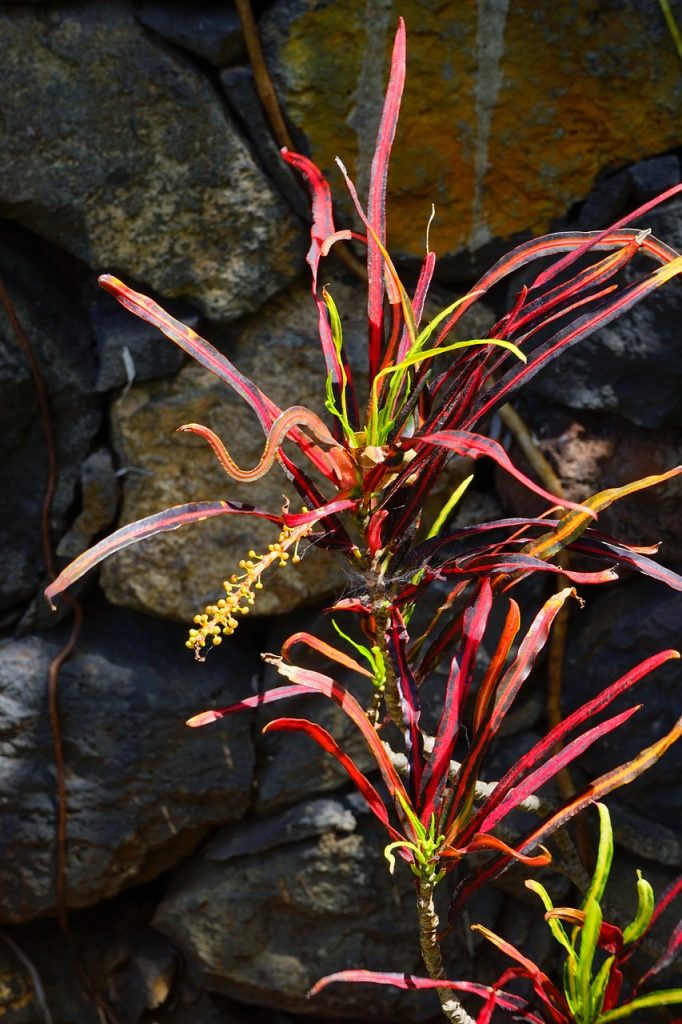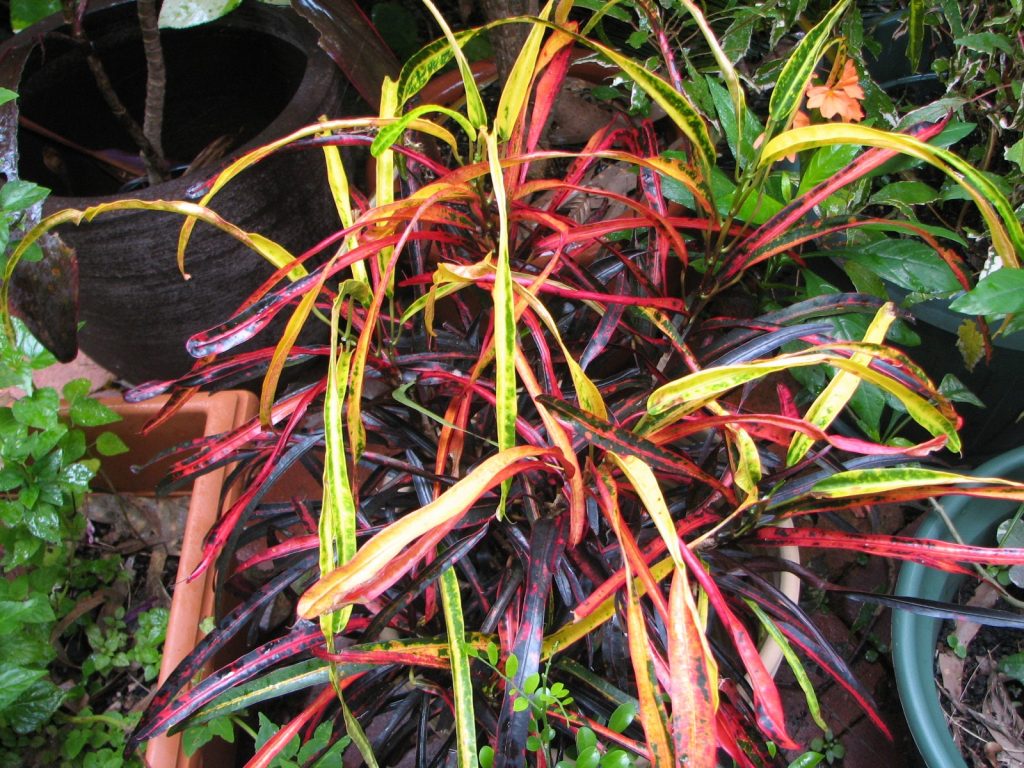Croton, Zanzibar is magnificent croton with vibrant gushing foliage that changes with the seasons and light conditions. It is a tropical plant found throughout the islands of the Western Pacific, as well as Indonesia, Malaysia, and Australia.
This species of croton is available for individuals who prefer leafy houseplants. The leaves of the Zanzibar croton are so thin that they appear to be grass stalks. Crotons aren’t very well known for their blossoms. The flowers produced by this plant family are inconsequential and scentless. They are little and resemble cherries in appearance.
Zanzibar thrives in a shaded courtyard or enclosed situation in warm, frost-free areas, where it forms a stunning showpiece in a display pot. It’s also lovely planted in the garden in a semi-shaded, well-drained spot, though it can handle periods of sunshine.
Croton plants are among the most beautiful houseplants available, and they add a pop of color to any space. The Zanzibar croton (Codiaeum variegatum) has a wide spectrum of hues, including red, purple, orange, yellow, green, and brown.
Croton Zanzibar Basic Information
Who doesn’t like brightly colored plants? We’re sure you do. The passion for these plants would be wasted if you didn’t know how to care for them properly. Let’s get you started by going over all you need to know about this particular croton species.
| Plant name | Croton Zanzibar |
| Botanical Genus | Codiaeum Variegatum |
| Plant type | Perennial |
| Native | Indonesia, Australia. |
| Soil type | Moist soil |
| Size | 5 ft. in height and 3 ft. in width |
| Watering | Moderate watering |
| Light | Bright indirect sunlight |
| Toxicity | Highly toxic |
| Foliage Color | Orange, purple, green, brown, yellow, red |

Croton Zanzibar Propagation
There are a variety of propagation methods for Croton Zanzibar, but we’ll focus on air layering propagation. It is one of the most straightforward methods for propagating croton plants. Not only that, to practice the Air layering approach, you do not need a lot of professional knowledge of how it’s done. If you follow through, you should end up with a stunning, full-fledged Zanzibar Croton.
Items needed for propagation:
We have provided a list of the items necessary for propagating the Zanzibar Croton. These items can be purchased from a nearby store.
- Twist ribbons
- Rope or electrician’s tape,
- Sphagnum moss
- Plastic film
- Plastic wrap
- A clean, sharp knife
Steps To Propagate The Zanzibar Croton
Here is a step-by-step guide on how to propagate the Zanzibar Croton houseplant:
Step 1: Make two skin cuts into the stems.
Step 2: Remove the skin cuts’ stems.
Step 3: Remove the cambium.
Step 4: Apply air-layered soil to the injured part of the stem.
Step 5: Wrap the plastic wrap around the soil on both sides.
Step 6: Let it sit for at least 30 days or about a month. The roots would have appeared by then.
Step 7: Remove the plant material after you have roots and place it in a nice container like any other plant.
Croton Zanzibar Care Instructions
Croton Zanzibar can survive in practically every season and may grow in either moderate or full sun. You must, however, understand how to properly care for your plant so that it grows healthily and retains its beauty. Take note of the following tips as they would be helped through your propagation journey.
1. Temperature
Make sure your Zanzibar Croton has the proper temperature while you keep it indoors. It should be placed near a bright window and sprinkled with water regularly. In high temperatures, it does not thrive well. During the hottest hours of the day, keep the Croton Zanzibar indoors as much as possible. Between 60 °F- 70 °F is the ideal temperature for your Croton Zanzibar.
2. Water
The best time to water a Croton plant is based on the circumstances. Because the soil should never be left dry for an extended period, it can be done daily or monthly. To avoid overwatering and root damage, check to see if the soil is dry before watering. In the summer, water your Croton plant evenly. In the summer, keep the soil moist, and in the winter, keep it somewhat dry.
3. Light
Your Croton Zanzibar’s leaves will fade if exposed to too much sunlight and vibrant foliage. If it receives little light, it will not develop the vibrant colors that make it such an appealing addition to your tropical garden. If you want to grow crotons in the shade, make sure it’s light and dappled rather than dark and shady, or the plant will lose its bottom leaves.

4. Humidity
Croton Zanzibar, fortunately for you, does not require extra humidity and will thrive in your home. In addition, because croton Zanzibar, like other plants, collects water through its root system rather than its leaves, you should water the soil as much as possible to keep your Zanzibar moist.
5. Soil
The croton Zanzibar thrives best in moist, well-drained, slightly acidic soil. If you’re going to buy potting soil from the shop, make sure to add some perlite to make it rich enough for your plant.
6. Pruning
Note that the Croton Zanzibar can be pruned at any time of year. However, trimming it when it is actively growing or when cold weather is expected is not recommended. They do not go dormant because they are perennials, but their development rate is slowed throughout the winter.
The optimum time to prune the croton of Zanzibar is usually in early spring, which is April. Before pruning your plants, soak the blades with rubbing alcohol or Lysol and let them air dry.
7. Fertilizer
Fertilize your lawn twice a year using a slow-release fertilizer at the recommended rate. Remember, however, that too much fertilizer can harm your crotons, so read the package recommendations carefully to figure out how much and how often to feed them.
Growing Tips
Repotting your croton plant too often might be stressful. This plant can be repotted every 12 months for the first three years. However, if you suspect it has gotten root-bound as it matures, you should merely replant it.
Problems with Croton Zanzibar
Croton Zanzibar leaves are resistant to a variety of diseases, but they are susceptible to a few. Among them are the ones listed below:
1. Crown Gall Anthracnose
This disease occurs when bacteria enter the roots through planting, grafting, or physical damage. A crown gall can always be detected when rough and wood-like galls form certain parts of the plant such as the root or stems. The effect of Crown gall on your Croton Zanzibar is that it would hinder the flow of nutrients from your soil to the plant.
2. Oedema
This is usually attributed to aging. Some parts of the plants start to harden and darken than the rest of the plant. A severe case of Oedema would cause your leaves to experience sparse growth and death.
3. Mildew
This is the effect of a bacterial infection that causes pale yellow spots to appear on the foliage surface of your Croton Zanzibar. It could affect both the upper and lower surface of the plant.
4. Root Rot
Waterlogged soil is the leading cause of Root rot. Root rot occurs when the soil is overwatered for a prolonged period. It weakens the soil and makes it prone to infections. One notable symptom of root rot is a rotten smell from the soil.
5. Pest Infestations
Crotons are also vulnerable to a number of pests. Some of these pests include Aphids, Spider mites, and Mealybugs. If not addressed promptly, these pests can cause considerable plant damage.
Transplanting Guide
Plant Zanzibar in healthy, well-draining potting soil. Heavy soils that retain water are the source of root rot. In slightly acidic soil, crotons thrive. When growing outside, keep the soil moist by applying organic mulch. These are the steps that would help you transplant your Croton Plant successfully:
- Step 1: Make a hole that is slightly bigger than the root ball in the organic soil.
- Step 2: Position the plant in the hole you have created.
- Step 3: More soil should be added.
- Step 4: To settle the soil, moderate add water to the mix.
Whether you’re growing in a container or the garden, these instructions can be followed.
Can Croton Zanzibar leaves fall off?
Yes, your Croton Zanzibar leaves can fall off. When you observe this, however, do not be alarmed. They may fall off due to several circumstances.
It could be a disease that has infected your plant, or it could be a result of the environment. They can also fall off due to distress, which is almost always caused by a change, although it can also be caused by a change in location, humidity, temperature, an illness, or a pest infestation.
Removing the source of your plant’s distress will quickly restore its vibrant appearance. In any case, simply recognizing the problem allows you to begin working on resolving it right away. You have nothing to be concerned about as long as the plant can renew its leaves. Before you know it, the shine of your croton plant would have returned.
FAQs
Does the croton plant grow fast?
No, the croton is a slow-growing plant that grows fewer than 12 inches per growing season. However, in ideal conditions, houseplants develop rapidly (lots of light and damp soil). Crotons can grow to be three or four feet tall in just a few years if they aren’t pruned.
Is the Croton Zanzibar poisonous?
Yes, the Croton Zanzibar is poisonous. Both humans and animals can be poisoned by the Croton Zanzibar. When consumed, it causes bloating, gas, and indigestion. If you come into contact with the poisonous sap in their stems and leaves, it may irritate your skin. The plant, on the other hand, might be hazardous if consumed. Because Crotons are so unpleasant to eat, your child or pet has a low chance of absorbing a significant amount of sap.
Final Thoughts
Croton Zanzibar is a beautiful plant that is simple to grow and maintain if you follow the guidelines we have provided. Also, pay attention to details and clean your Croton Zanzibar regularly.
Avoid overwatering and subjecting the plant to harsh temperatures as much as possible while nurturing.
Although Croton plants from Zanzibar are disease and pest-resistant, you should monitor your plant regularly for signs of infection. To prevent mishaps, keep this striking houseplant in a secure position where pets and kids can appreciate it without touching it.
Other croton variety care guides:

